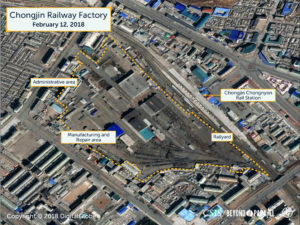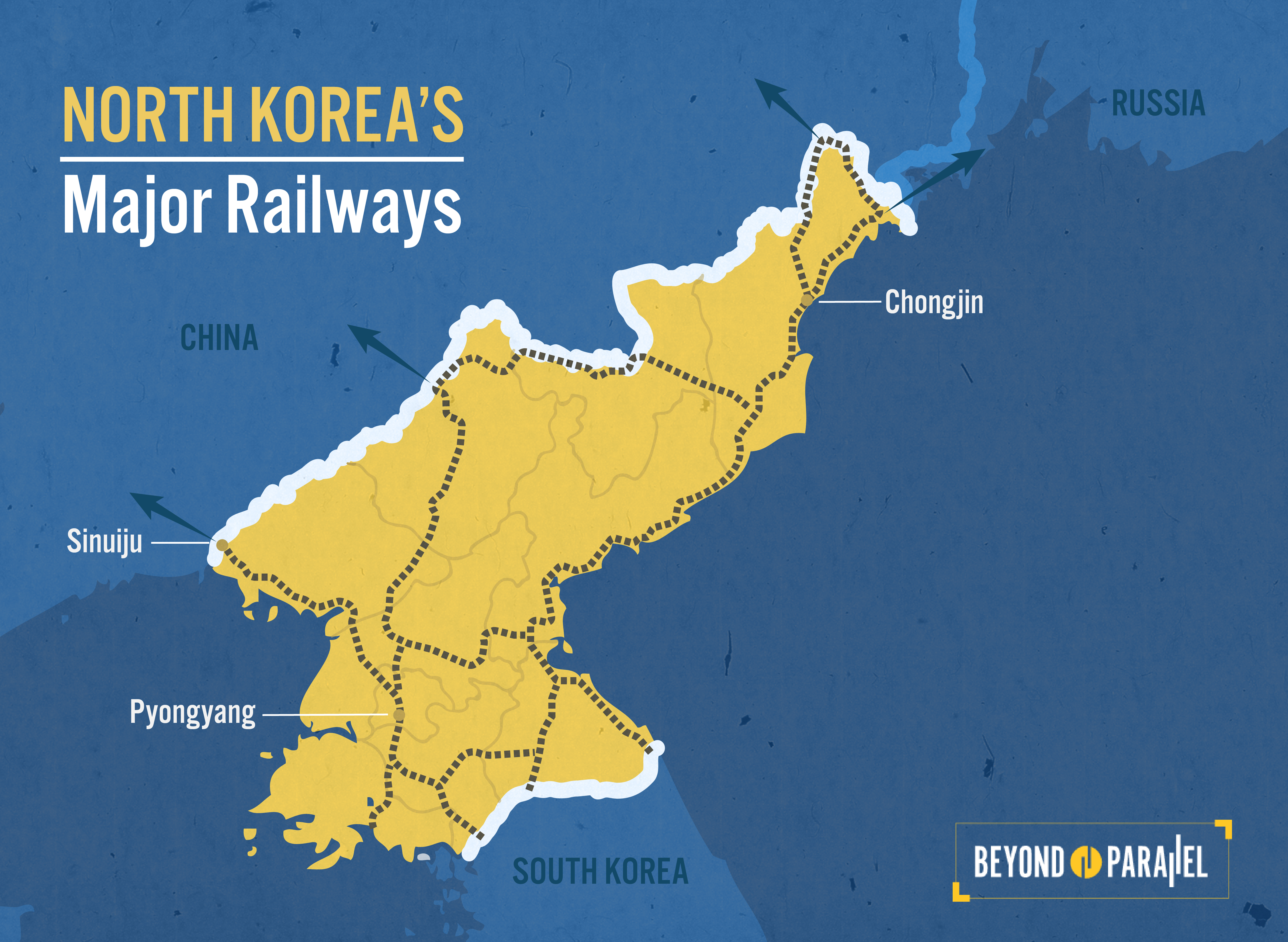
Across the Tracks: North Korean Railcar Manufacturing and the 2018 Inter-Korean Agreement
The Center for Strategic and International Studies Korea Chair and the National Geospatial-Intelligence Agency partnership uses unclassified geospatial imagery and data to produce new, timely, and accurate reporting on the North Korean economy and society, infrastructure, and border activities. The first report created as part of the partnership looks at North Korean railway infrastructure at the Chongjin Railway Factory.
Read the Full Report.
Connection and modernization of railways in the Korean peninsula’s eastern transportation corridor is a declared step within the historic April 27, 2018 joint declaration for peace, prosperity, and unification.
Chongjin Railway Factory is one of three major railway manufacturing facilities in North Korea’s eastern corridor. Analysis of this facility can be a brick-and-mortar sign-post of foundational infrastructure progress if the trust-building project of reconnecting the Koreas’ railways is carried out.
Railway manufacturing facilities have served as a necessary link in North Korea’s underdeveloped economy, presently offer new possibilities in inter-Korean relations, and will be foundational infrastructure for future unification. However, knowledge of North Korea’s infrastructure is lacking according to a pilot survey of regional experts conducted by CSIS Beyond Parallel. The following in-depth study of North Korea’s railcar manufacturing infrastructure seeks to begin to address that void.
North Korea’s railroad system, with over 7,400 kilometers (km) of track, is critical both to the North Korean economy and national defense, serving as the primary means for long-haul cargo and passenger transportation.1 Chongjin city, the largest city by square kilometers outside North Korea’s capital, is a key part of this system as the most significant hub on the North Korea section of the freight rail line connecting Beijing, China, and Khasan, Russia, and one of a handful larger hubs in the domestic railway network. Most significantly, Chongjin is also home to North Korea’s second-most active trading port, accounting for 24.2 percent of the country’s import/export activity in general cargo, agricultural goods, coal, and steel. The Chongjin port has a handling capacity of approximately 8 million tons, second only to that of Nampho in the southwest.2 It boasts the second-greatest length of dock space usable by commercial shipping in the country at approximately 2,888 meters.
The railway factory located in Chongjin, therefore, plays a relatively unassuming, yet vital connecting role in the regional and national economies. As efforts progress to modernize and reconnect the eastern transportation corridor between North and South Korea under the April 27 Panmunjeom Declaration, the railcars produced and serviced at the Chongjin Railway Factory could play an increasingly important role. The Chongjin Railway Factory is one of just five major industrial facilities that undertake railcar production and depot-level repairs for the nationwide network. It is primarily engaged in the manufacture, repair, and scrap of railcars. Some small parts are likely manufactured within the factory, while others are scavenged from scrapped railcars or procured from local light industries. While the factory is active, commercial satellite imagery shows this activity is at a lower-than-anticipated level for a facility of this size and layout, suggesting shortages of raw material, energy, financial resources, administrative malaise, economic limitations, or any combination of these.
The Chongjin Railway Factory (41.793718 129.796317) is located in the eastern section of Chongjin city and adjacent to the Chongjin Chongnyon Rail Station. As of February 2018, the Chongjin Railway Factory is an active repair and production facility and is being maintained at a reasonable level by North Korean standards. While there are approximately 140 railcars of various types present in the railyard, there are no visible indications of any significant new railcar production. This activity, however, could easily be missed if it is undertaken at a low level.
Despite the importance of railway system and by extension its associated manufacturing facilities, outside knowledge of North Korea’s infrastructure is lacking, according to a pilot survey of regional experts conducted by Beyond Parallel. When experts from the United States, South Korea, Japan, and Russia were polled, approximately 50 percent said they believed there was insufficient or no empirical analysis available on infrastructure. For example, of the South Korean experts surveyed, 46 percent said this of China, 50 percent of Japan, and 71 percent of Russia.
Commercial satellite imagery indicates the primary type of railcars manufactured and serviced at the factory are gondolas and hoppers used primarily to haul mineral ore and coal from mines to heavy industries and powerplants in the province, especially the Songjin Iron and Steel Complex, Sonbong Thermal Powerplant, Kimchaek Iron and Steel Complex, and Chongjin Structural Steel Works. In turn, the Kimchaek Iron and Steel Complex and Chongjin Structural Steel Works provide the finished and semi-finished products to the Chongjin Railway Factory for railcar manufacture and repair.
Aside from the movement of rail cars, few external changes of significance have been observed at the factory between 2006 and 2018 with the exception of the replacement of an assembly/repair hall roof between 2016 and 2017, and the replacement of roofs on a second assembly/repair hall roof and support building between 2017 and 2018.
With regards to the movement of railcars, those positioned on tracks leading to the main assembly/repair hall on the east side of the facility exhibit regular changes in numbers and types of railcars present. A number of tracks on the west side of the yard, apparently used to store railcars for scavenging spare parts and eventual scrapping, have railcars that have not moved in years.
The imagery also shows piles of rubbish throughout the facility. However, this is somewhat typical of railroad facilities such as this and should not necessarily be taken as an indicator of level of activity. Obvious in any summer or fall imagery of the factory is that almost all open space at the Chongjin Railway Factory is used for gardening. While such gardening is typical of large industrial facilities in North Korea, the level seen at the Chongjin Railway Factory appears somewhat high which is likely an indicator of a reduced level of railway-related activity.
Read the Full Report.
References
- See also Hsun, Chiang, Hong Kong Businessman Breaks Bottleneck of China-North Korea Railway Transportation, Yazhou Zhoukan, October 29, 2005, http://www.yzzk.com ↩
- Dongwoo Yim and Rafael Luna, eds., “North Korea Atlas,” South Korea: Damdi Publishing Co., May 2004. 173; 219. ↩


